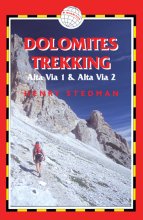Worth watching out for.
— John Cleare

Dolomites Trekking
Excerpt:
Minimum impact trekking
Contents | Introduction | Route options and when to go | With a group or independently? | Sample route guide | Minimum impact trekking

The Dolomites is a surprisingly fragile environment, and one that is coming under increasing pressure every year because of the sheer volume of people who flock to the mountains. It is therefore vital that everybody who visits the Dolomites should do their bit to preserve the region. Below is a list of simple
but essential rules that, if followed, will help to minimize the damage done to the environment and protect the Dolomites for future generations:
Don't leave litter
Everything you take up to the mountains with you should either be eaten, buried if it's biodegradable, burnt (in the case of toilet paper – see below) or carried back down the mountain to the nearest bin. Many people leave litter for rifugi staff to deal with but this is wrong; you should take all your rubbish with you.
Don't pick the flowers
Many species of alpine flora are already quite rare, including the famous edelweiss. It is very tempting to pick just a few but don't; leave the flowers for others to enjoy.
Stay on the trail
Erosion is a serious problem in parts of the Dolomites. The authorities, however, are able to deal with just one path being eroded. it's when there are many paths, caused by people choosing their own way up or down a mountainside instead of sticking to the main route, that the staff of the national parks have their work cut out. don't make extra work for them: stick to the main trail.
Burn toilet paper
All loo paper should be burned and faeces buried. Certain trekking routes in Nepal have been nicknamed toilet trails after the vast amount of (used) toilet paper left to hang from trees or on the path itself by thoughtless trekkers. If you have to use toilet paper on the trail, burn it afterwards.
Don't pollute water sources
If you need to relieve yourself on the trail, do so at least 20 metres away from streams, lakes and other water sources. Similarly, if you are washing clothes or hair in the mountains, take the water from the stream or lake in a bucket to a place at least 20 metres away from the source and do your washing there.
Dolomites Trekking
Excerpts:
- Contents
- Introduction
- Route options and when to go
- With a group or independently?
- Sample route guide
- Minimum impact trekking
Latest tweets